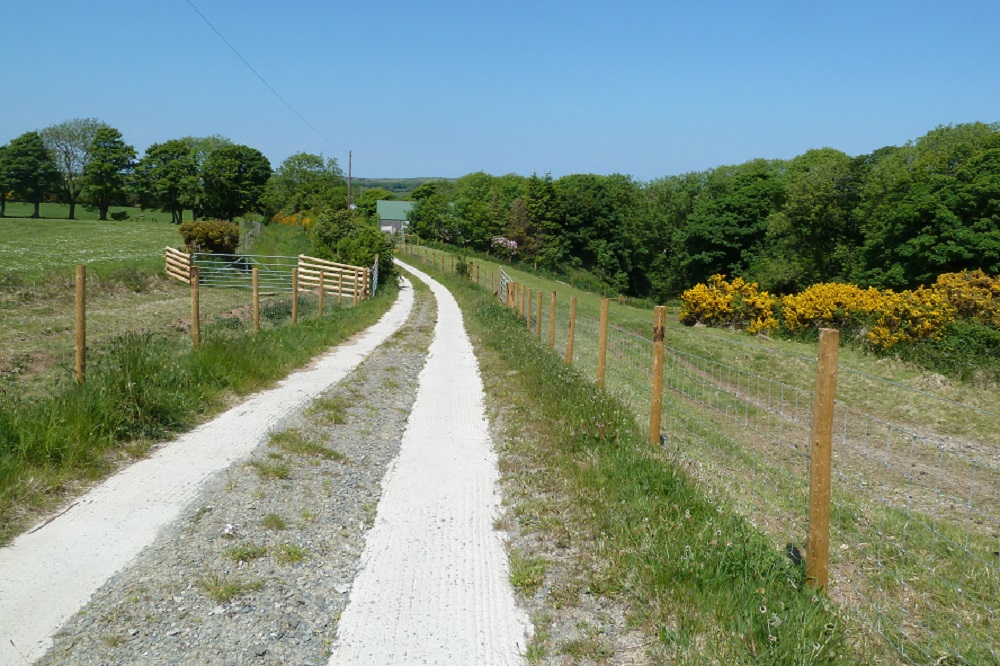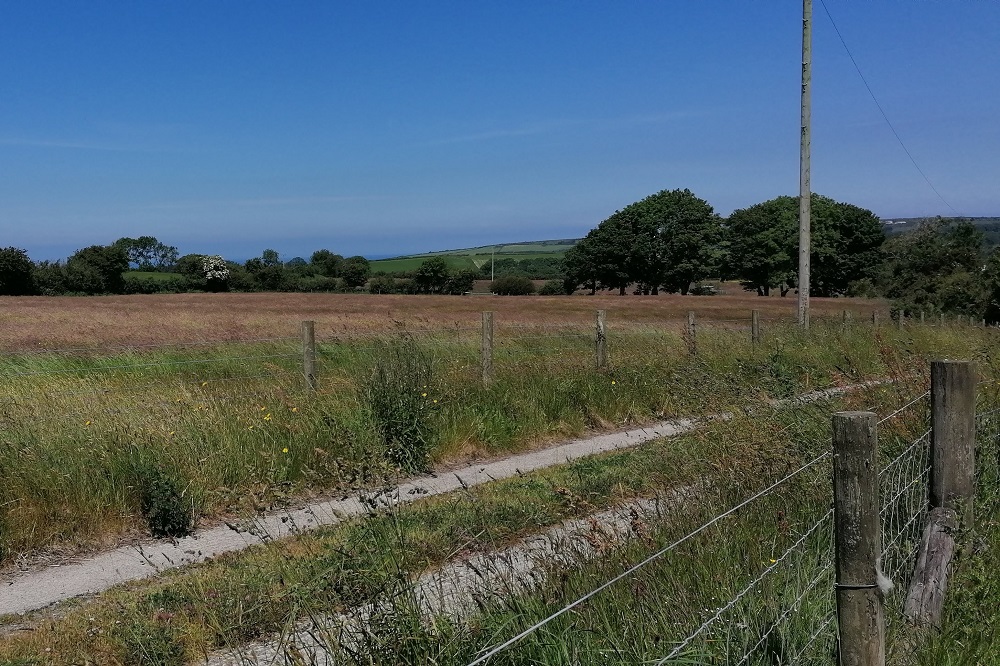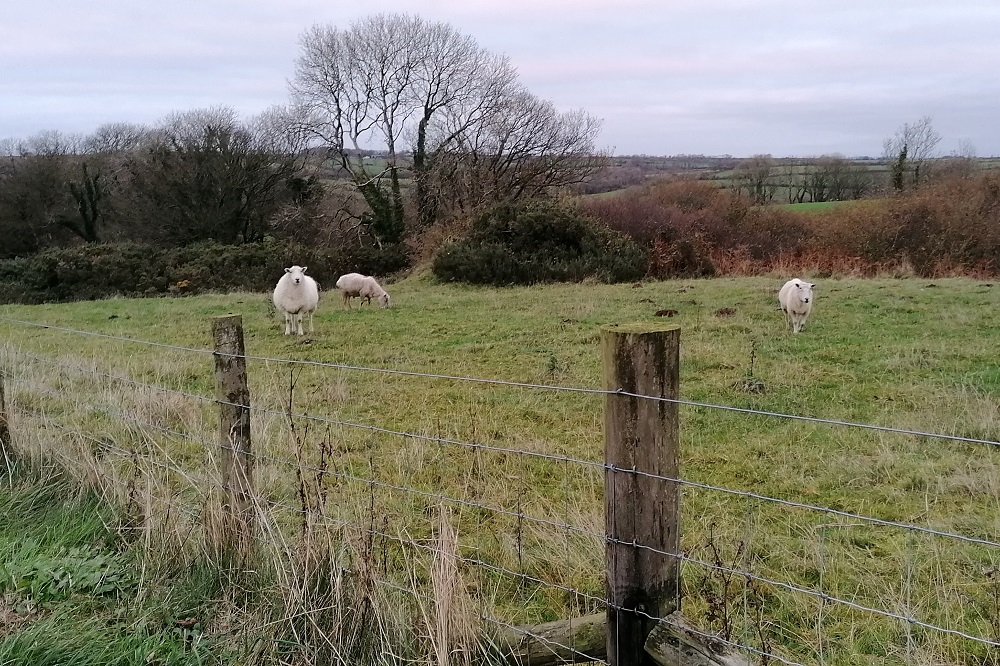Cynefin – A Sense of Place: The Lane part one

Gaynor Funnell
The driveway from the front door to the top of our lane is a third of a mile long and people only come down it to see me or to deliver something. Or if they’re lost.
The mail gets delivered to an American style box which is situated at the junction of the lane and the road that leads to Moylegrove, so I walk up the steep slope to check for post every day and have done for the last ten years.
The box itself lies in wait in the blackthorn hedge, which is ready to attack anyone who gets too close, so I often take secateurs with me to trim the blackthorn as I don’t want myself or the postman to get stabbed by its vicious spikes.
Tiny pieces can break-off under your skin and turn septic, so not getting too near them is best (unless it’s autumn and you’re wanting to pick the sloes for gin).
We had to replace the cracked and pitted drive when we moved in, as half of it ended up in a moraine-like mass of mud and shale and gravel outside the farmhouse following the first winter storm.
Two lines of concrete now run from top to bottom, leaving a narrow strip of green in-between, a strip that has become colonised with seeds carried down by the rain, the water pouring down the new track as if someone has pulled a plug.
Nectar
Where the overhanging hedge casts a shadow, the strip of green is of dog violet, self-heal, grass, and where the sun shimmies through the gaps, the green is of daisy, wild strawberry, black medick, plantain.
Red clover bridges the space and spreads between the two, handily growing opposite the beehives which lie halfway along the track. Its common name is honeystalks, because you can suck a tiny drop of nectar from a floret, something I remember doing as a child.
Red clover’s flowers are more pink than red, and what appears to be a flower is in fact an inflorescence, a cluster of skyward facing tubular florets of cerise and rose-pink. In the shade, they stretch their necks to follow the sun, whilst on the dry shale side they bask and sprawl sideways.
The bees seem to love them, almost falling out of their hive to lie and fly amongst the blooms, and although the flower tube is sometimes too long for the honeybee to reach into to collect nectar, they have no difficulty in collecting pollen.
This collects on their heads, and the bee then uses its front legs to transfer the brown pollen into the pollen basket on their hind legs, which look like saddlebags when they’re full. It’s relaxing to watch the bees foraging, and the garden is full of flowers I’ve planted for them.
Along with the wild plants already present such as ivy, sycamore, willow and apple, there’s something for every season – crocus, snowdrop, hellebore, foxglove, honeysuckle, single roses, lavender, buddleia, marjoram, thyme, raspberry, sedum, mahonia.
Floral taste
Apparently, ten bee-loads of pollen are needed to produce one worker bee, which is a lot of pollen.
Last summer, I made lemonade from the red clover flowers. You have to pick them before the pompom flowers turn brown, then simmer them with honey, letting the liquid steep overnight before adding the juice of a lemon.
It turns the colour of a ripe apricot and has a delicate, floral taste. It’s supposedly full of isoflavones, vitamin C, potassium and calcium and is thought to act as diuretic, an expectorant, and to help cleanse the liver.
I just like the fact that I can source the flowers and the honey are from outside my front door.

Cartws
The track runs between two fields, Parc Cartws, or First field on the right on the way up, and Parc Main or Quarry field on the left. Main means thin, and it is a narrow piece of land, and the English name is self-explanatory – there’s a small shale quarry in the top part of it. The sides are steep, but as yet, no animal has fallen in.
Half of the quarry is surrounded by gorse bushes, which shine a neon yellow for months and flood the hollow with an Hawaiian tropic smell on a warm day, and is the summer home to stonechats, meadow pipits and yellowhammers.
First field is also self-explanatory as it’s the first field you see when you come down the lane. I call it that rather than Cartws, as that is what we called it when we arrived, not then knowing its original name.
Cartws means Cart house, so there must have been one somewhere on the field, although there’s no evidence of one now. Old maps show the field was divided into two until the hedge was pulled out years ago.
There’s a cattle grid at the top of the track which is supposed to prevent animals from escaping or entering.
It doesn’t: one of our sheep – a cross between a Welsh mountain and a Lleyn – regularly jumped, rolled or tightroped along the metal bars, sometimes with a lamb in tow, and a neighbour’s sheep regularly appeared to eat the garden I’d planted for the bees.
We’d planned to fill the grid in, worried that creatures such as hedgehogs or frogs would fall into it and be unable to get out, but it was another job we never got around to.
Checking for potential casualties became a daily habit although I had no plan on how to remove anything if they did fall.
In summer, the drain is colonised by plants that enjoy the damp coolness – the emerald green, smooth-to-the-touch birds nest fern, unravelling curls of bracken, and foxgloves, which get decapitated every time they became tall enough to peer over the edge.
Dave placed a cut scaffold plank across one side to walk across, as I had visions of my foot getting stuck.

Hint of a breeze
Once over the cattle grid, you can turn right to Moylegrove, or left which takes you towards the road to Nevern.
There are five gateways in a rough circle – ours, leading into Cartws field; next doors field, Pwll Hedydd, to the left; opposite, two more fields that used to belong to Penbanc – Rhos Isaf and Rhos fach; and centrally, heading west, Parc Stand, a path that leads to the viewpoint at Crugiau Cemaes.
Rhos means moorland, but the field shows little evidence of this now. Years of soil improvement have made it a rich pasture for cattle and sheep.
When I reach the five gates, I know without thinking, which way the wind is blowing depending on where it touches the skin on my face. Today, a hint of a breeze is touching my left cheek, so it’s arriving from the south.
When the wind blows strongly from the east, the gates sing, an otherworld pan-pipe sound. Although the gates are made from metal, each is made slightly differently, so hum at different pitches.
It was difficult to work out where the noise was coming from the first time I heard it and it scared the dogs, but I like it, like the evidence of wind as a presence. The wind has its own character here, has moulded and bullied the landscape and the trees.
Some days, when reaching this spot, I just stand and close my eyes. Feel the sun, the wind, the rain. Absorb the atmosphere. Listen. You can hear more when you close your eyes, all the other senses compensating for a temporary loss of vision.
Today, a blackbird is singing; a lamb is calling; a swallow twitters and chirps; a tractor rattles in the distance, and there’s a faint smell of grass touched by the sun. I can almost hear it growing.
I wonder about the people that have walked this same path before me, when the lane was earth, not concrete. Did they do the same? Or where they too busy trying to earn a living from the land to stand and close their eyes.
Gaynor Funnell is the winner of the Nigel Jenkins award for 2022. We are delighted to be publishing a series about Penbanc over the coming months, with support from the H’mm Foundation.
You can read the serialisation so far here
Support our Nation today
For the price of a cup of coffee a month you can help us create an independent, not-for-profit, national news service for the people of Wales, by the people of Wales.





Sweet
Beautifully written it sounds idyllic.
Nothing worse than a viscous spike, sorry, I give up with books with speelling misteaks.